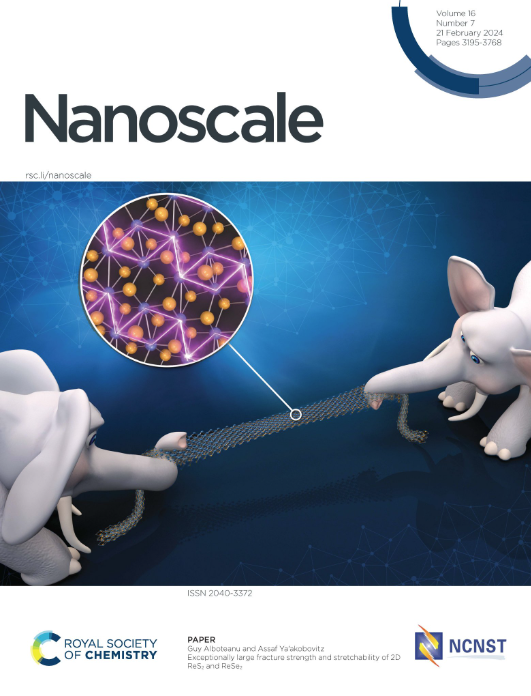微调Ni/Co比值阐明mof衍生的高敏感无酶乳酸生物传感器双金属层状双氢氧化物配位构效关系
IF 5.1
3区 材料科学
Q1 CHEMISTRY, MULTIDISCIPLINARY
引用次数: 0
摘要
开发一种可靠的非酶电化学乳酸检测传感器对于实时监测肌肉疲劳和人体代谢至关重要。在这项工作中,我们提出了一种在碱性介质中由金属有机骨架(MOF)前驱体衍生的镍钴双金属层状双氢氧化物(LDH)的直接可控合成方法。系统调整Ni/Co比可诱导不同的氢氧化物相变,其中高Ni含量有利于形成具有较强催化活性的α-相氢氧化物,而高Co含量有利于形成β-相氢氧化物。先进的x射线吸收光谱(XAS)和拉曼分析表明,优化后的富镍LDH具有独特的混合八面体(Oh)/四面体(Td)配位结构,具有四面体优势结构,增强了电荷转移和电子导电性。此外,富含ni的LDH促进了三价金属(Ni3+/Co3+)的形成,促进了乳酸氧化所必需的更强的氧化还原活性。优化后的富镍LDH修饰的丝网印刷碳电极表现出优异的电化学性能,在碱性介质中,在0~12.5 mM的乳酸浓度范围内,在0.60 V (vs. Ag/AgCl/ 3m KCl)的电位下,获得了63.66±3.86µa mM⁻¹的高灵敏度。此外,所提出的生物传感器具有出色的重复性,在室温下18天后保持其初始响应的85.70%,突出了其长期应用的显着稳定性。该研究为mof衍生的LDHs的结构-活性关系提供了有价值的见解,并为开发高性能、无酶的乳酸生物传感器提供了一条有希望的途径,用于无创监测生理状况。本文章由计算机程序翻译,如有差异,请以英文原文为准。
Fine-Tuning Ni/Co Ratio to Elucidate the Coordination Structure-Activity Relationship of MOF-derived Bimetallic Layered Double Hydroxide for Highly Sensitive Enzyme-free Lactate Biosensors
The development of a reliable, non-enzymatic electrochemical sensor for lactate detection is crucial for real-time monitoring of muscle fatigue and human metabolism. In this work, we present a straightforward and controllable synthesis method for nickel–cobalt bimetallic layered double hydroxide (LDH) derived from a metal-organic framework (MOF) precursor in an alkaline medium. The Ni/Co ratio was systematically tuned to induce distinct hydroxide phase transformations, where a high Ni content favored the formation of the α-phase hydroxide with superior catalytic activity, while a high Co ratio led to β-phase hydroxide formation. Advanced X-ray absorption spectroscopy (XAS) and Raman analyses revealed that the optimized Ni-rich LDH exhibited a unique mixed octahedral (Oh)/tetrahedral (Td) coordination, with a tetrahedral-dominant structure that enhanced charge transfer and electronic conductivity. Additionally, the Ni-rich LDH facilitated the formation of trivalent metal (Ni3+/Co3+) species, promoting stronger redox activity essential for lactate oxidation. The optimized Ni-rich LDH modified screen-printed carbon electrode demonstrated outstanding electrochemical performance, achieving a high sensitivity of 63.66 ± 3.86 µA mM⁻¹ within a lactate concentration range of 0~12.5 mM at an applied potential of 0.60 V (vs. Ag/AgCl/3 M KCl) in alkaline medium. Furthermore, as proposed biosensor exhibited excellent repeatability, maintaining 85.70% of its initial response after 18 days under room temperature, highlighting its remarkable stability for long-term applications. This study provides valuable insights into the structure-activity relationship of MOF-derived LDHs and offers a promising pathway for developing high-performance, enzyme-free lactate biosensors for non-invasive monitoring of physiological conditions.
求助全文
通过发布文献求助,成功后即可免费获取论文全文。
去求助
来源期刊

Nanoscale
CHEMISTRY, MULTIDISCIPLINARY-NANOSCIENCE & NANOTECHNOLOGY
CiteScore
12.10
自引率
3.00%
发文量
1628
审稿时长
1.6 months
期刊介绍:
Nanoscale is a high-impact international journal, publishing high-quality research across nanoscience and nanotechnology. Nanoscale publishes a full mix of research articles on experimental and theoretical work, including reviews, communications, and full papers.Highly interdisciplinary, this journal appeals to scientists, researchers and professionals interested in nanoscience and nanotechnology, quantum materials and quantum technology, including the areas of physics, chemistry, biology, medicine, materials, energy/environment, information technology, detection science, healthcare and drug discovery, and electronics.
 求助内容:
求助内容: 应助结果提醒方式:
应助结果提醒方式:


